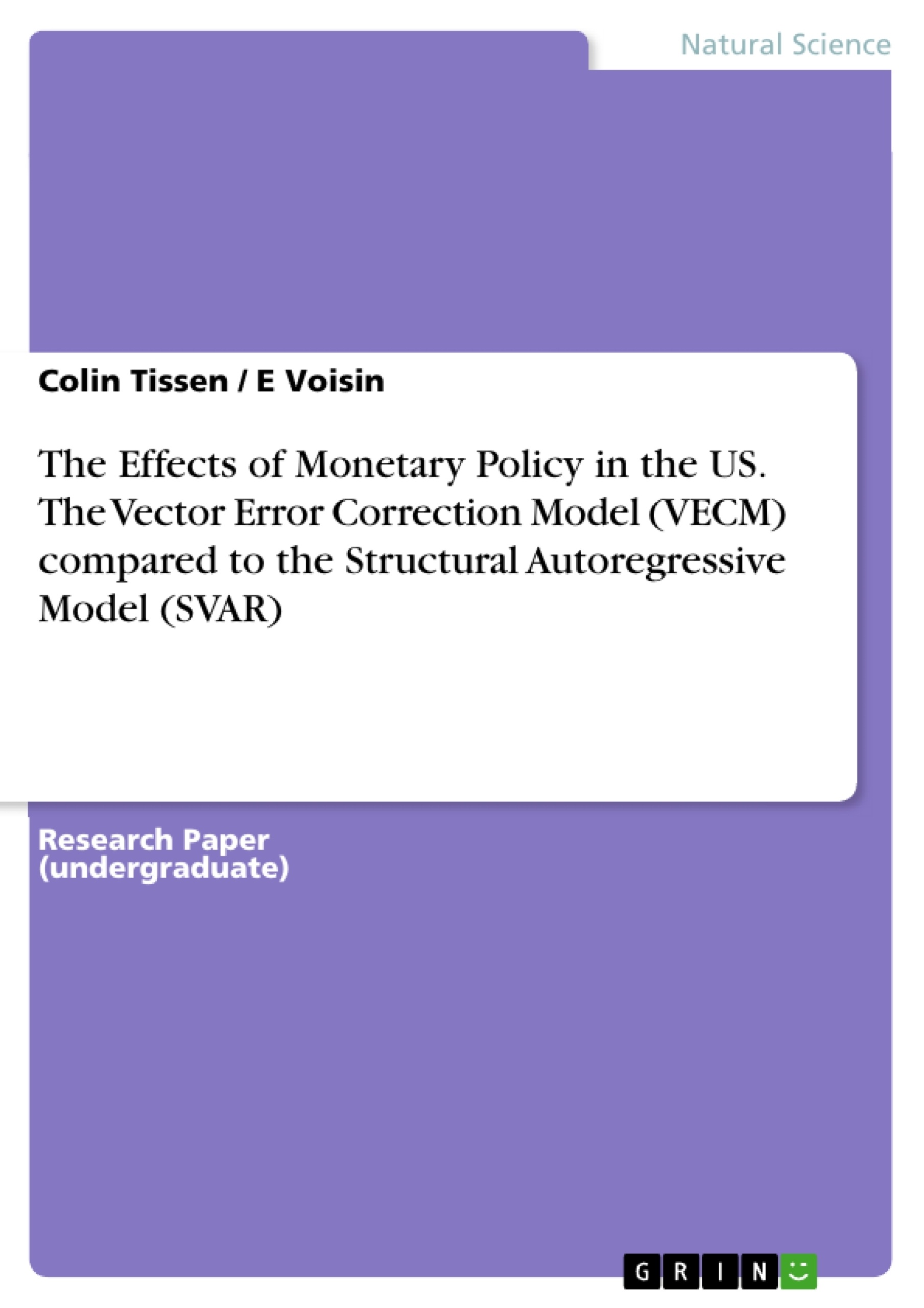This paper investigates the effects of monetary policy in the US by comparing a system of equations – estimated from a VECM (vector error correction model) – to a SVAR (structural autoregressive) model. Vector error-correction models are used when there exists long-run equilibrium relation-ships between non-stationary data integrated of the same order.
Those models imply that the stationary transformations of the variables adapt to disequilibria between the non-stationary variables in the model. In contrast, SVAR models focus on the contemporaneous interdependence between the variables. The authors apply these two methods on a model with a contractionary monetary policy which affects the short-term interest rate. Following Sims and Zha the authors use a shock to the Treasury Bill rate instead of a shock to the Federal Funds rate.
The paper continues as follows. First, a description of the data is given. Secondly, it presents a system of equations built from the LSE approach, aiming at macroeconomic simulations. Thirdly, it compares results obtained from the previous part to those obtained using SVAR impulse response functions (IRFs) identified with sign restrictions. The paper focuses on the impact of the simulated policies or monetary shocks on GDP and its growth rate.
Inhaltsverzeichnis (Table of Contents)
- Introduction
- Data
- The LSE approach
- Vector error correction model
- Simulations
- Coefficients instability
- Structural VAR
- Sign restrictions.
- Impulse response functions
- Conclusion
Zielsetzung und Themenschwerpunkte (Objectives and Key Themes)
This paper investigates the effects of monetary policy in the US by comparing two models: a vector error correction model (VECM) and a structural autoregressive (SVAR) model. The study uses historical data from July 1959 to March 2017 to examine the relationship between monetary policy shocks and key macroeconomic variables, primarily focusing on the impact on GDP and its growth rate.
- The impact of monetary policy shocks on the US economy
- Comparison of VECM and SVAR models in analyzing monetary policy effects
- The role of cointegration relationships in macroeconomic modeling
- Application of sign restrictions in identifying SVAR impulse response functions
- The impact of the 2008 financial crisis on monetary policy and the US economy
Zusammenfassung der Kapitel (Chapter Summaries)
- Introduction: The paper introduces the topic of monetary policy analysis and its importance in macroeconomics. It explains the focus on non-systematic monetary policy movements and the use of shocks and structural identification to estimate their effects. The study outlines its methodology, using a VECM and a SVAR model to analyze the impact of monetary policy on the US economy, particularly on GDP and its growth rate.
- Data: This section presents the data used in the study, describing the monthly time series data from July 1959 to March 2017. The variables include real GDP, real M2, real gross private domestic investment, real personal consumption expenditures, inflation rates (both from the Consumer Price Index and commodity price index), nominal return on M2, interest rate on three-month Treasury Bills, total reserves, and the unemployment rate. The section also explains data transformations and the stationarity properties of the variables.
- The LSE approach: This chapter outlines the LSE approach to econometric modeling, contrasting it with the Cowles Commission approach. It emphasizes the importance of the reduced form and the focus on identifying cointegration relationships. The chapter describes the use of a vector error correction model (VECM) to capture long-run equilibrium relationships between macroeconomic variables.
- Vector Error Correction Model (VECM): This section details the estimation of the VECM. It explains the determination of the number of lags and the application of Johansen cointegration test, leading to the identification of three statistically significant cointegrating relationships. Each cointegrating equation is then discussed, highlighting the long-run relationships between output, consumption, interest rates, market rates, and inflation.
Schlüsselwörter (Keywords)
The paper focuses on the impact of monetary policy on the US economy, using both VECM and SVAR models. It explores the relationship between monetary policy shocks, GDP, and inflation, utilizing cointegration analysis, impulse response functions, and sign restrictions. The analysis includes variables such as real GDP, real M2, real investment, real consumption, inflation rates, interest rates, total reserves, and unemployment.
- Arbeit zitieren
- Colin Tissen (Autor:in), E Voisin (Autor:in), 2017, The Effects of Monetary Policy in the US. The Vector Error Correction Model (VECM) compared to the Structural Autoregressive Model (SVAR), München, GRIN Verlag, https://www.hausarbeiten.de/document/377268


